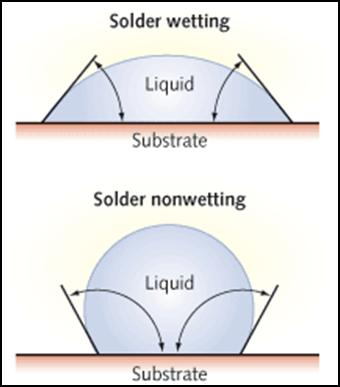Die bonding with eutectic solder processing is becoming more important as thermal challenges increase with the proliferation of laser diode assemblies. A solder joint functions as both the electrical contact and the primary heat transfer interface between the die and its substrate. Lasers also require precise temperature control during operation, and the required drive current rises rapidly with increased operating temperatures. Without a robust thermal interface, increased device temperatures severely degrade light output performance and device longevity.
In a eutectic solder bond—where eutectic means "easily melted"—solder reacts with a small amount of the base metal to form an intermetallic, covalent bond. The intermetallic compound is typically hard and brittle, and it is the source of strength of the solder joint.
For eutectic soldering to occur, the metal must be at the eutectic temperature, the thermal conductivity of the metal must be in the correct range and the contact angle on the metal's surface must be minimized.
 The eutectic temperature for a metal is the temperature and percent mixture where a substance will go directly from pure solid to pure liquid. At any point on the phase diagram above the eutectic line, the mixture is 100% liquid, and any point below, it is a solid. The thermal conductivity of the substrate requires that there is some means of heating the joint area where the solder is placed. However, the applied heat cannot be so excessive that it damages surrounding components.
The eutectic temperature for a metal is the temperature and percent mixture where a substance will go directly from pure solid to pure liquid. At any point on the phase diagram above the eutectic line, the mixture is 100% liquid, and any point below, it is a solid. The thermal conductivity of the substrate requires that there is some means of heating the joint area where the solder is placed. However, the applied heat cannot be so excessive that it damages surrounding components.
In terms of wetting, the joining surfaces must permit molten solder to wet and spread during the available time window without significant de-wetting. For the best wetting, the contact angle q must be minimized. The dividing line between "good" and "bad" wetting is usually considered to be a contact angle of 90°. Issues arise when contaminants are introduced to the surface, referred to as passivation. Passivation layers affect wetting by forming a barrier between the solder and base metal, and these layers are typically oxide films that may be only a few angstroms thick. Other elements, such as nickel, can form passivation films that require fluxes (solvents) or plasma cleaning to remove. Oils, silicones and organics are frequent contaminants that can also form barriers to wetting and act as a passivation layer.
Beyond the basic requirements for eutectic soldering, many additional factors contribute to conditions required for a robust solder joint, including die metallization, temperature and the substrate material itself.
In gold metallization, the metallization thickness, composition, contaminants and coverage applied during this process are all key factors to solder the die. Usually the equipment used to solder the die must adapt all process variables to accommodate the existing die fabrication and metallization properties. Temperature control is important to solder joint formation because excessive temperature can blister the thin coating, rendering the module useless. Also, higher temperatures promote the formation of oxides that are barriers to wetting.
To apply heat to a sub-assembly, there are two primary methods pulse heat profiling and steady-state heating with a scrubbing action. Scrub attachment is a quick, straightforward, and reliable process, but a downside of the process is mechanical agitation of the die. Pulse heat profiling is mechanically less stressful to but often involves additional process planning. Understanding which bonding process matches a particular package design leads to smart thermal management decisions which result in maximum yielded throughput and profit.
In terms of choosing the right substrate material, ceramic carriers are popular as substrates because of their availability, cost and heat transfer characteristics. They are mostly alumina-based compounds. In attempts to drive broadband packaging costs lower, some customers are migrating to copper-plated substrates. Unfortunately, copper materials at high temperatures rapidly form a thick copper oxide layer if exposed to the atmosphere. To solder to a copper base, aggressive cleaning processes before bonding and an inert forming gas environment during bonding are required.
When contemplating design decisions for packaging components, process and design engineers should carefully consider the implications of the various eutectic assembly inputs and processes required for successful die bonding, especially when looking for ways to reduce costs.
Side note: check out the best interactive periodic table yet to be found online www.ptable.com
----
Jessica Sylvester
Marketing Communications
Palomar Technologies